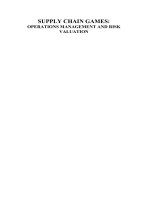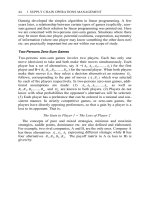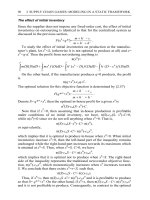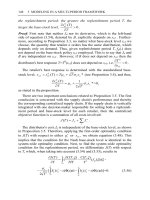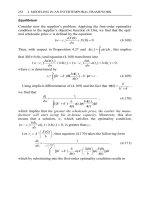Operations management heizer 6e ch11
Bạn đang xem bản rút gọn của tài liệu. Xem và tải ngay bản đầy đủ của tài liệu tại đây (441.71 KB, 56 trang )
Operations
Management
Chapter 11 –
Supply-Chain Management
PowerPoint presentation to accompany
Heizer/Render
Principles of Operations Management, 6e
Operations Management, 8e
© 2006
Prentice
Hall, Inc. Hall, Inc.
©
2006
Prentice
11 – 1
Outline
Global Company Profile:
Volkswagen
The Strategic Importance Of The
Supply Chain
Global Supply-Chain Issues
Supply-Chain Economics
Make-or-Buy Decisions
Outsourcing
© 2006 Prentice Hall, Inc.
11 – 2
Outline – Continued
Ethics in the Supply Chain
Supply-Chain Strategies
Many Suppliers
Few Suppliers
Vertical Integration
Keiretsu Networks
Virtual Companies
© 2006 Prentice Hall, Inc.
11 – 3
Outline – Continued
Managing the Supply Chain
Issues In an Integrated Supply Chain
Opportunities in an Integrated
Supply Chain
Internet Purchasing
Vendor Selection
Vendor Evaluation
Vendor Development
Negotiations
© 2006 Prentice Hall, Inc.
11 – 4
Outline – Continued
Logistics Management
Distribution Systems
Cost of Shipping Alternatives
Logistics, Security, and JIT
Benchmarking Supply-Chain
Management
© 2006 Prentice Hall, Inc.
11 – 5
Learning Objectives
When you complete this chapter, you
should be able to:
Identify or Define:
© 2006 Prentice Hall, Inc.
Supply-chain management
Purchasing
Outsourcing
E-procurement
Materials management
Keiretsu
Virtual companies
11 – 6
Learning Objectives
When you complete this chapter, you
should be able to:
Describe or Explain:
Supply-chain strategies
Approaches to negotiations
© 2006 Prentice Hall, Inc.
11 – 7
Volkswagen
Brazilian plant employs 1000
workers
200 work for VW and are responsible
for overall quality, marketing,
research, and design
800 work for other contractors and do
the assembly work
VW looks to innovative supply
chain to improve quality and drive
down costs
© 2006 Prentice Hall, Inc.
11 – 8
Volkswagen
Important elements of this concept
VW is buying not only materials, but
also the labor and related services
Suppliers are integrated tightly into
VW’s own network, right down to
assembly work in the plant
Purchase costs in the auto industry
exceed 60% of the sales dollar, so any
savings are significant
© 2006 Prentice Hall, Inc.
11 – 9
Volkswagen
© 2006 Prentice Hall, Inc.
11 – 10
The Strategic Importance
of the Supply Chain
Supply-chain management is the
integration of the activities that
procure materials and services,
transform them into intermediate
goods and the final product, and
deliver them to customers
Competition is no longer between
companies; it is between supply chains
© 2006 Prentice Hall, Inc.
11 – 11
Supply-Chain Management
Important activities include determining
1. Transportation vendors
2. Credit and cash transfers
3. Suppliers
4. Distributors and banks
5. Accounts payable and receivable
6. Warehousing and inventory
7. Order fulfillment
8. Sharing customer, forecasting, and
production information
© 2006 Prentice Hall, Inc.
11 – 12
A Supply Chain
Figure 11.1
© 2006 Prentice Hall, Inc.
11 – 13
Global Supply-Chain Issues
Supply chains in a global environment
must be able to
React to sudden changes in parts
availability, distribution, or shipping
channels, import duties, and currency rates
Use the latest computer and transmission
technologies to schedule and manage the
shipment of parts in and finished products
out
Staff with local specialists who handle
duties, freight, customs and political issues
© 2006 Prentice Hall, Inc.
11 – 14
How Supply-Chain
Decisions Impact Strategy
Low-Cost
Strategy
Supplier’s
Goal
Supply demand
at lowest
possible cost
(e.g., Emerson
Electric, Taco
Bell)
Primary
Select primarily
Selection
for cost
Criteria
Response
Strategy
Differentiation
Strategy
Respond quickly Share market
to changing
research;
requirements
jointly develop
and demand to
products and
minimize
options (e.g.,
stockouts (e.g.,
Benetton)
Dell Computers)
Select primarily
for capacity,
speed, and
flexibility
Select primarily
for product
development
skills
Table 11.1
© 2006 Prentice Hall, Inc.
11 – 15
How Supply-Chain
Decisions Impact Strategy
Low-Cost
Strategy
Response
Strategy
Differentiation
Strategy
Process
Characteristics
Maintain high
average
utilization
Invest in excess
capacity and
flexible
processes
Modular
processes that
lend
themselves to
mass
customization
Inventory
Characteristics
Minimize
inventory
throughout the
chain to hold
down cost
Develop
responsive
system with
buffer stocks
positioned to
ensure supply
Minimize
inventory in the
chain to avoid
obsolescence
Table 11.1
© 2006 Prentice Hall, Inc.
11 – 16
How Supply-Chain
Decisions Impact Strategy
Low-Cost
Strategy
Response
Strategy
Differentiation
Strategy
Lead-Time
Characteristics
Shorten lead
time as long as
it does not
increase costs
Invest
aggressively to
reduce
production lead
time
Invest
aggressively to
reduce
development
lead time
ProductDesign
Characteristics
Maximize
performance
and minimize
costs
Use product
designs that
lead to low
setup time and
rapid
production
ramp-up
Use modular
design to
postpone
product
differentiation
as long as
possible
Table 11.1
© 2006 Prentice Hall, Inc.
11 – 17
Supply-Chain Economics
Supply Chain Costs as a Percent of Sales
Industry
All industry
Automobile
Food
Lumber
Paper
Petroleum
Transportation
% Purchased
52
67
60
61
55
79
62
Table 11.2
© 2006 Prentice Hall, Inc.
11 – 18
Supply-Chain Economics
Dollars of additional sales needed to equal $1
saved through the supply chain
Percent of Sales Spent in the Supply Chain
Percent Net Profit
of Firm
2
4
6
8
10
40%
$3.23
$3.13
$3.03
$2.94
$2.86
50%
$3.85
$3.70
$3.57
$3.45
$3.33
60%
$4.76
$4.55
$4.35
$4.17
$4.00
70%
$6.25
$5.88
$5.56
$5.26
$5.00
80%
$9.09
$8.33
$7.69
$7.14
$6.67
90%
$16.67
$14.29
$12.50
$11.11
$10.00
Table 11.3
© 2006 Prentice Hall, Inc.
11 – 19
Make-or-Buy Decisions
Reasons for Making
1.
2.
3.
4.
5.
6.
7.
8.
9.
10.
11.
© 2006 Prentice Hall, Inc.
Maintain core competence
Lower production cost
Unsuitable suppliers
Assure adequate supply (quantity or delivery)
Utilize surplus labor or facilities
Obtain desired quality
Remove supplier collusion
Obtain unique item that would entail a prohibitive
commitment for a supplier
Protect personnel from a layoff
Protect proprietary design or quality
Increase or maintain size of company
Table 11.4
11 – 20
Make-or-Buy Decisions
Reasons for Buying
1.
Frees management to deal with its primary
business
2. Lower acquisition cost
3. Preserve supplier commitment
4. Obtain technical or management ability
5. Inadequate capacity
6. Reduce inventory costs
7. Ensure alternative sources
8. Inadequate managerial or technical resources
9. Reciprocity
10. Item is protected by a patent or trade secret
© 2006 Prentice Hall, Inc.
Table 11.4
11 – 21
Outsourcing
Transfers traditional internal
activities and resources of a firm to
outside vendors
Utilizes the efficiency that comes
with specialization
Firms outsource information
technology, accounting, legal,
logistics, and production
© 2006 Prentice Hall, Inc.
11 – 22
Ethics in the Supply Chain
Opportunities for unethical behavior
are enormous and temptations are high
Many companies have strict rules and
codes of conduct that define
acceptable behavior
Institute for Supply Management has
developed a detailed set of principles
and standards for ethical behavior
© 2006 Prentice Hall, Inc.
11 – 23
Principles and Standards for
Ethical Supply Management
Conduct
LOYALTY TO YOUR ORGANIZATION
JUSTICE TO THOSE WITH WHOM YOU
DEAL
FAITH IN YOUR PROFESSION
Table 11.5
© 2006 Prentice Hall, Inc.
11 – 24
Principles and Standards for
Ethical Supply Management
Conduct
1.
Avoid the intent and appearance of unethical or
compromising practice in relationships, actions, and
communications
2.
Demonstrate loyalty to the employer by diligently
following the lawful instructions of the employer, using
reasonable care and granted authority
3.
Avoid any personal business or professional activity that
would create a conflict between personal interests and
the interests of the employer
Table 11.5
© 2006 Prentice Hall, Inc.
11 – 25




